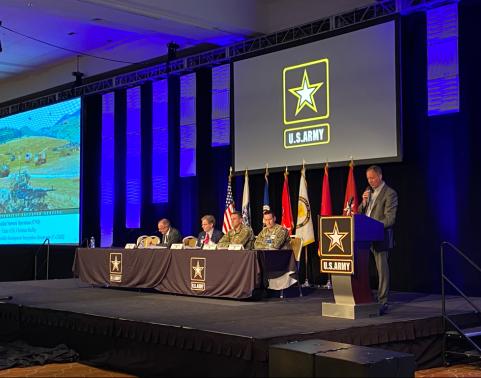PEO EIS leaders bring enterprise perspective to meeting on Army’s network strategy

PEO EIS leaders took part May 9-10 in the eighth network-related technical exchange meeting (TEM 8) hosted by the Network Cross-Functional Team and Program Executive Office Command, Control and Communications – Tactical (PEO C3T) in Philadelphia, Pennsylvania. The purpose of the meeting was to discuss Capability Set 25/27 development efforts and focus areas.
On day one of the meeting, EIS’ assistant program executive officer for networks, cyber and services, John Howell, took part in a panel on Unified Network Operations (UNO) to provide an update on the Army’s UNO strategy and program execution efforts.
From an acquisition perspective, EIS is working closely with C3T on an acquisition strategy for various capabilities under the UNO construct. In the past, this had been difficult due to not having a Unified Network strategy or any actual requirements for capabilities.
“A coordinated acquisition strategy between PEOs is bigger than just ensuring that POMs [program objective memorandums] match and that we’re singing the same tune and using integrated tools,” said Howell. “It’s a matter of focusing on the capabilities.”
Network operations are not static, Howell pointed out, so the Army needs to ensure it’s staying ahead of — or is at least parallel with — available technology capabilities. “When new threats emerge, we have to have the capabilities to address them,” he said.
The goal is a coordinated, synchronized network operations solution that delivers capability but also meets stakeholder needs. Industry can help the Army attain this goal by identifying synchronization solutions instead of individual tools, added Howell.
On the enterprise network side of the house, EIS is supporting the Army’s Unified Network Plan through three separate initiatives: identity, credential and access management (ICAM), global SIPR [secure internet protocol router] modernization and voice modernization. EIS is following the Army G-6 ICAM roadmap, said Howell, and in a related effort will execute the Army’s requirements definition package a couple of years down the road. More than one ICAM contract will likely be awarded.
Regarding global SIPR modernization, Howell said the Army needs to “get away from doing the network the same old way.” Instead, regionalization is needed, as well as a commercial solution for classified, and multiple independent levels of security.
Meanwhile, voice modernization is not just an enabler but a cost saver and optimizer, said Howell. “Why are we still refreshing hard phones?” he asked. “We need to get to collaborative capabilities, get rid of TDM [time-division multiplexing] and old POTS [plain old telephone service] with no place in today’s modern Army.”
EIS Program Executive Officer Ross Guckert echoed Howell’s emphasis on collaboration while participating in a data and cloud-centered panel on day two of TEM 8.
If the Army is going to make the unified network successful, said Guckert, it will need an architecture that enables data to flow from the tactical network to the enterprise network and back. That requires collaboration with industry.
“We need to get the data where it needs to be at the right time,” he said. “What should that look like, industry?” he asked.
Guckert also acknowledged EIS’ close coordination with C3T on matters involving the unified data fabric.
“It’s a work in progress,” he said. “We need to understand how it will be managed and set up governance.”
Ultimately, getting the core components in place will benefit Army decision-makers at all levels.
“If we get the data fabric and network architecture correct, leaders will have access to artificial intelligence, machine learning and predictive analytics when they need it,” said Guckert.
Related News
-
Onedia James: a logistician and leader with a family legacy of service
April 22, 2025Onedia James recently stepped into the role of acting deputy project manager for Army Data and Analytics Platforms (ARDAP) at U.S. Army Program Executive Office (PEO) Enterprise, where she helps oversee and support the data portfolio’s four programs. -
PEO Enterprise’s new PL Digital Market reimagines IT product/service procurement
April 2, 2025FORT BELVOIR, Va. – U.S. Army Program Executive Office (PEO) Enterprise today announced the launch of the Product Lead (PL) Digital Market, which replaces PL Computer Hardware, Enterprise Software and Services (CHESS), effective Apr. 2, 2025. -
Two vastly different Army programs prepare for Software Acquisition Pathway
March 24, 2025At U.S. Army Program Executive Office Enterprise, which is now over two years into its Agile transformation, several enterprise software programs are already in the execution phase of the DOD’s Software Acquisition Pathway, which is designed to facilitate rapid and iterative delivery of software capability to users.
Work for Us
Join a winning team! Search for job opportunities with PEO Enterprise.
Work with Us
Help support important missions. Explore ways your company can work with PEO Enterprise.